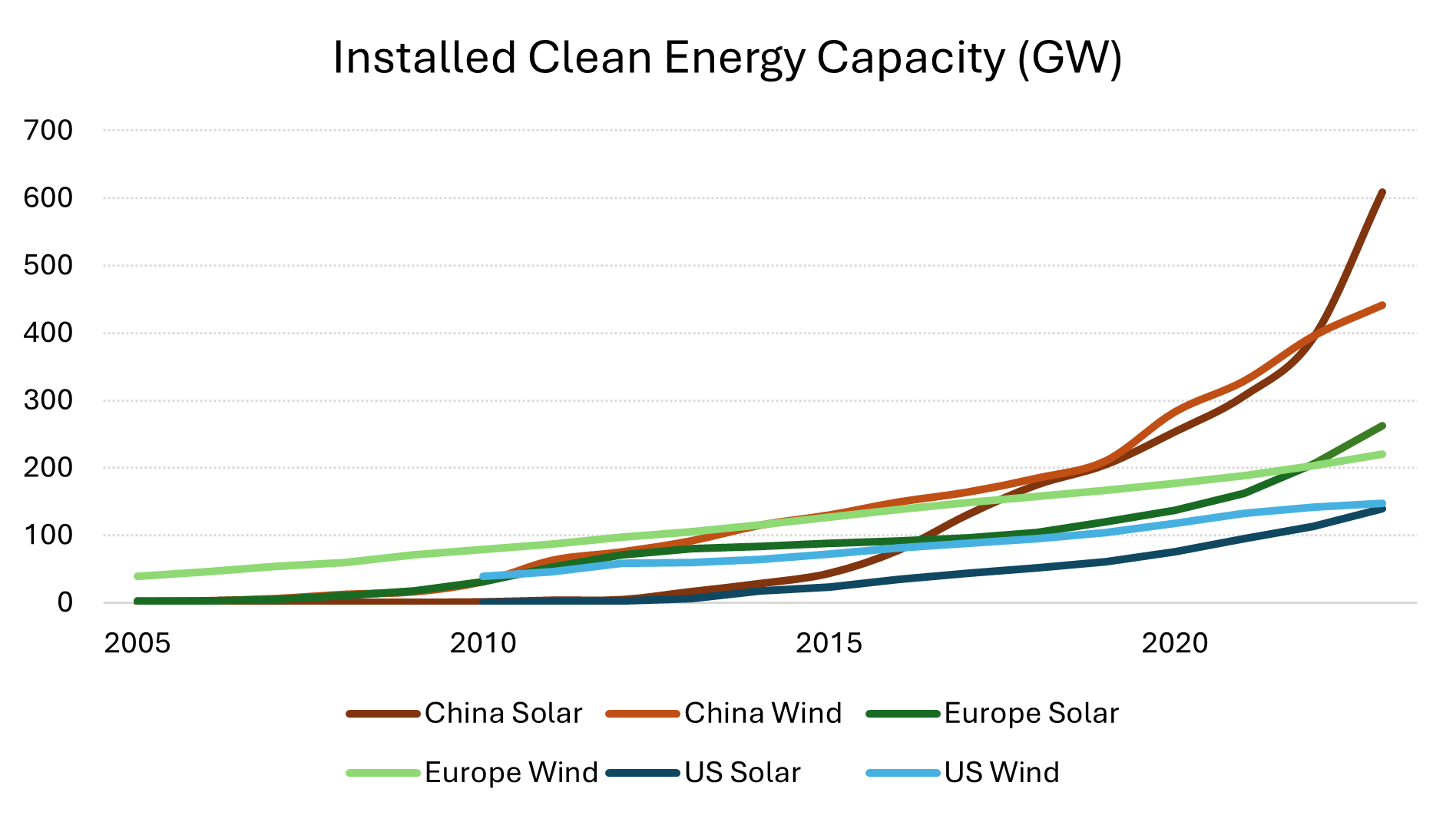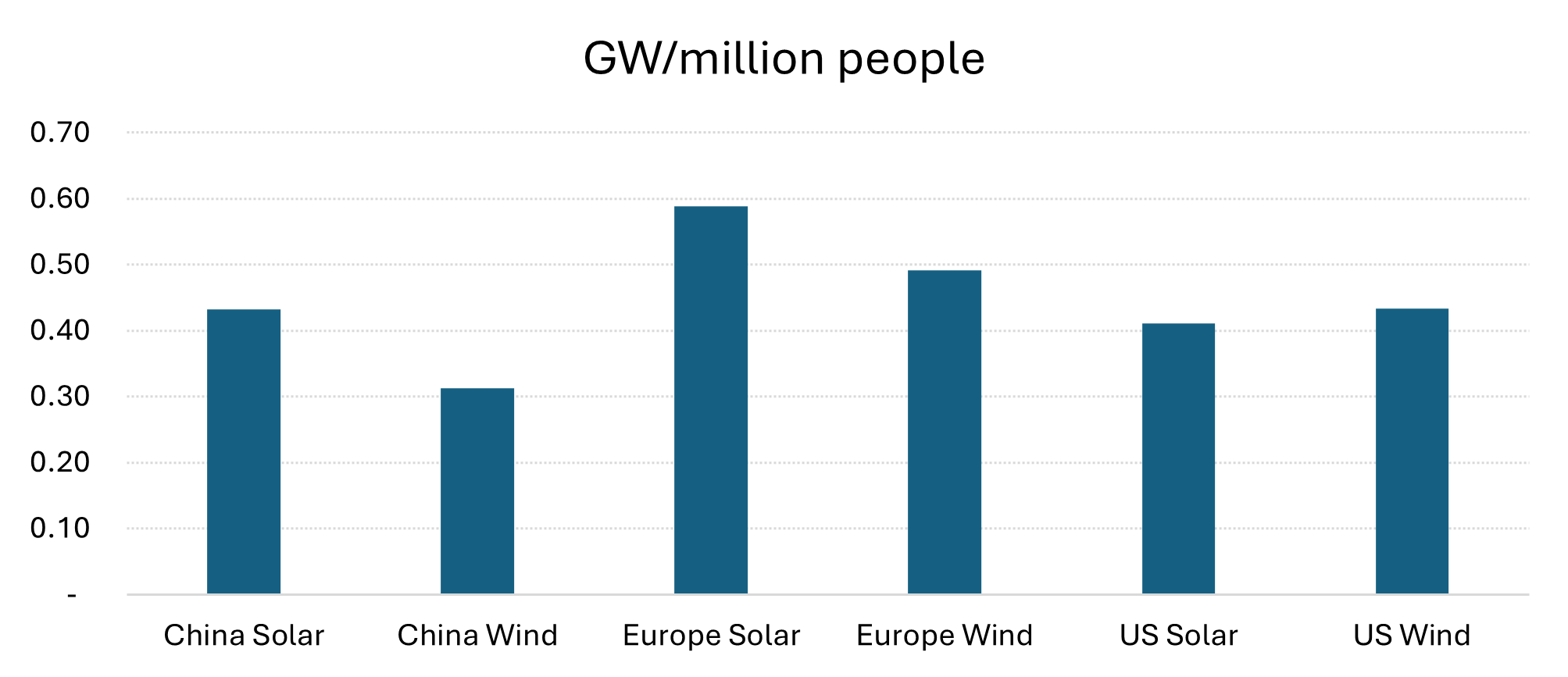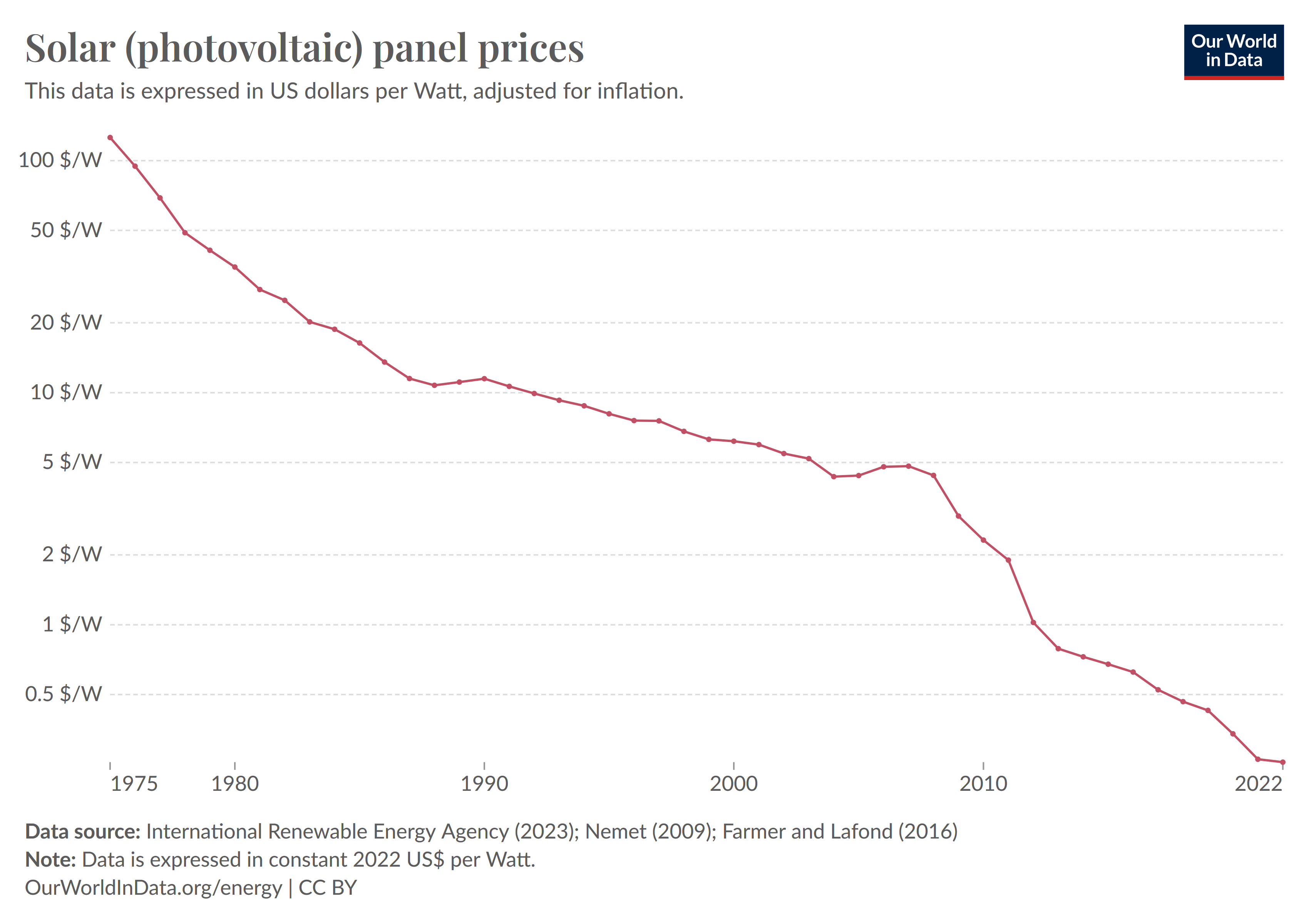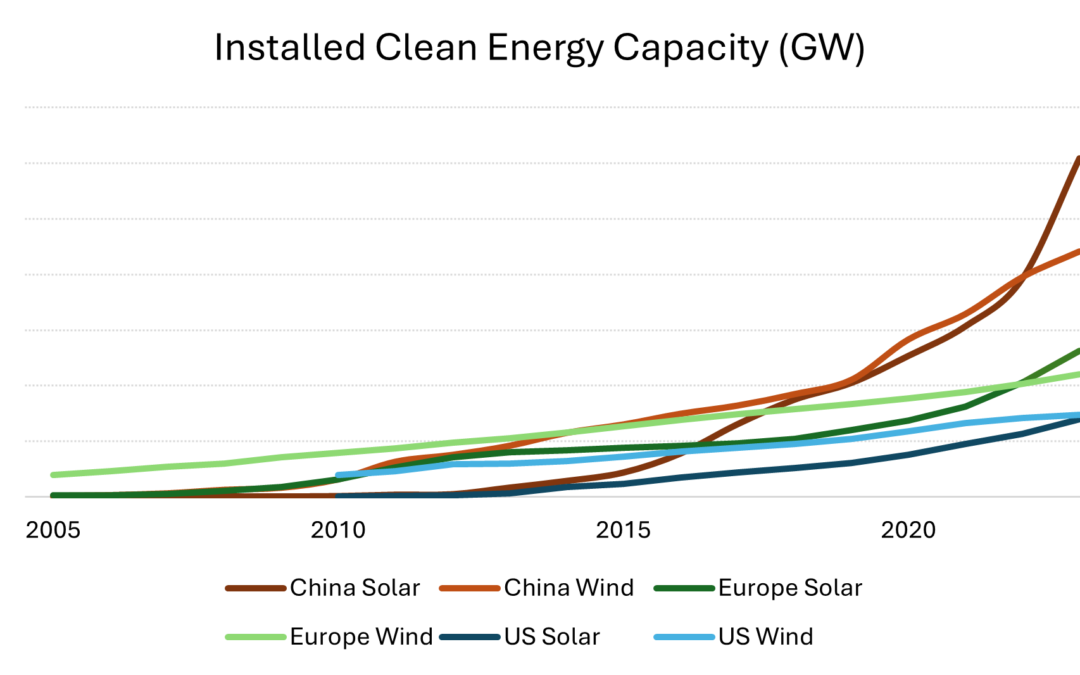How fast is the energy transition progressing? Exponentially. And this despite the complaints about its slow pace from various sources[1]. Let’s consider different drivers supporting an optimistic view of the transition.
Growth and technological progress
Solar has been leading the exponential path when it comes to technology, compared to wind. And country-wise, China, which is well known to be dominating the solar PV market, has been leading, with a rapid acceleration in the last couple of years. In Europe we all want renewable energy but there always seems to be a good reason to oppose renewable projects – of course each situation deserves to be analysed case-by-case[2], but culture and political systems do play a role[3]. A more pragmatic approach by certain countries could also help to reaccelerate the transition in Europe – Germany being an example[4]. As joked about the difficulties of Nobel-prize winner Giorgio Parisi to get approvals to install solar panels in the building where he lives, winning a Nobel Prize may seem easier than getting a small residential renewable project done. But despite all these obstacles and more than a few (partially justified) alarmed and pessimistic voices, we are in fact enjoying exponential growth in renewable, clean energy capacity.

Sources: Eurostat, U.S. Energy Information Administration, Climate Cooperation China, Wikipedia.
One chart cannot tell the full story, of course. On a per-capita basis, Europe still has a leadership position, and the very early leadership in this field by the Old Continent should be acknowledged. Also, there are fair questions asked about the solar value chain in China that accounts for three quarters of solar modules globally according to the IEA[5]. While some doubts are, to a certain extent, likely also politically driven, there are trade-offs on various fronts. Nevertheless, China’s implementation of its cleaner energy agenda has been remarkable and a source of optimism for the environment against widespread gloom.

Sources: see above.
Futurist Ray Kurzweil stress that people often, if not generally, neglect the exponential pace of technological evolution. Instead, we predict and project future developments based on linear dynamics, so we underestimate the pace of progress in the long term. Of course, not every technological development follows an exponential pattern, so this theory should not be indiscriminately generalized. However, the exponential chart on installed capacity is one point in favour of an optimistic medium-term forecast and the chart below, tracking the exponential improvement in solar PV panel prices, is another indication and reason for optimism with regards to the pace of the energy transition.

Sources: see figure, retrieved from OurWorldInData [6].
And there are more reasons for optimism. The price of batteries has been following a similar exponential pattern and even more examples could be found. It is indeed no news that the powerful combination of renewable clean energy with (cost-efficient) battery storage is a great improvement for the attractivity of weather-driven sources like wind and solar. Or let’s consider that while current commercial PV efficiency is around 20%, the Fraunhofer Institute achieved an almost 48% efficiency in 2022. Although the efficiency pattern is not exponential[7], such continuous innovation combined with economies of learning and scale may well continue to support the exponential improvement in cost per unit of output. Another impressive example of future planned exponential growth is that of direct air capture technologies (DAC), with companies like ClimeWorks looking to grow capacity 10X every 2 years[8]. This pace of capacity growth would also be associated with a steep cost improvement in a virtuous cycle, as seen in other situations.
The role of (exponential) capital
On the capital side as well, there has been an exponential growth in the money invested in the energy transition. According to a Bloomberg NEF presentation titled Energy Transition Investment Trends 2024, the recent acceleration from less than $600bn to almost $1.8tn is another exponential boost that should support optimism for the decarbonisation of the world economy. In all statistics, methodology plays a crucial role, so any number needs to be taken with due care, but if we believe at least approximately in these numbers, the 3.1X increase in 4 years from 2019 to 2023 compared to the 3.7X increase in 10 years from 2009 to 2019 is remarkable. And always according to the same source, it is worth noting that China is investing almost twice as much as Europe in the energy transition and leads in terms of climate-tech financing. It also has 3x the population, so on a per capita basis, it still ranks behind Europe and the U.S., but having the country with the largest shares of global emissions leading in the energy transition according to certain key statistics, is an important step in the right direction. Capital can deliver impact. And if both capital (including VC, PE/PC as well as traditional energy companies) and technology (in the renewable energy space in combination with other industrial sectors such as automotive, steelmaking, etc.) continue to work together each at its exponential pace, well, we may soon find out that we are doing better than feared.
Psychological considerations
The human weakness stressed by Kurzweil with respect to grasping exponential growth patterns and integrating them into their forecasts, has been researched by others as well, and labelled the exponential growth bias. Schonger and Sele (2021) make an interesting point: one of our misconceptions about exponential growth is that it has to result in “fast growth” from the very beginning. This, the authors point out, can be highly misleading, as initially moderate growth rates (in absolute numbers) may belong to an exponential function that we don’t recognise for what it is until growth picks up (again, in absolute numbers) dramatically. Levy and Tasoff (2017), analyse the exponential growth bias and connected overconfidence, highlighting the evidence for the bias and the tendency for the least accurate participants to be the most overconfident about their ability to deal with exponential growth.
On a different note, there is currently a lot of negative news about China, on many fronts, from the local economy to broader geopolitical considerations. And some in the West are probably still attached to a certain stereotypical image of China’s progress, despite it having an extremely strong competitive position in areas such as AI and the solar industry. China has problems – who hasn’t – but also has strengths: according to a common ranking[9], one leading Chinese university, also particularly strong in AI, is just one step below the ETH Zurich. While from the chart shown earlier one clearly cannot conclude that the country is leading the energy transition – the subject is much more complex than that – we should also beware biases such as the representativeness bias or the (negative) halo effect. Judging certain characteristics, trends, developments, etc. based on stereotypes or other not necessarily related characteristics, is a common heuristic, sometimes efficient but sometimes leading to biased and incorrect conclusions. Things are hardly black-and-white, although heuristics tend to prefer such binary views, as they are less computationally intensive for our brain.
Up to us to analyse ourselves and debias with regards to exponential growth patterns, whether optimist, pessimist, or – we would wish – realist.
Footnotes / Sources
[1] https://www.eiu.com/n/energy-transition-will-move-slowly-over-the-next-decade/; https://www.cnbc.com/2023/03/28/renewables-energy-transition-is-way-off-track-irena-report-says.html
[2] https://www.euronews.com/green/2024/03/07/sami-activists-backed-by-greta-thunberg-reach-deal-to-save-reindeer-farming-from-giant-win; https://www.swissinfo.ch/eng/business/solar-parks-boom-but-so-does-opposition/48206238;
[3] https://www.politico.eu/article/germany-green-wind-power-electricity/
[4] https://www.energyvoice.com/renewables-energy-transition/wind/europe-wind/547070/germany-looks-to-end-nature-checks-to-aid-offshore-wind/
[5] https://www.iea.org/reports/solar-pv-global-supply-chains/executive-summary
[6] Solar (photovoltaic) panel prices (ourworldindata.org). CC BY licence.
[7] https://www.nrel.gov/pv/cell-efficiency.html
[8] https://www.scottishmortgage.com/en/non-uk/non-uk-shareholders/insights/ic-podcast/scottish-mortgage-podcast-s2-episode-5-climeworks-carbon-removal-pioneers-10043560
[9] https://www.timeshighereducation.com/world-university-rankings/2024/world-ranking#!/length/25/sort_by/rank/sort_order/asc/cols/scores

